Part 1: DirectX 11 Gaming And Multi-Core CPU Scaling
We test five theoretical Intel CPUs in 10 different DirectX 11-based games to determine what impact core count has on performance.
Grand Theft Auto V & Hitman (2016)
Grand Theft Auto V
Rockstar requires a quad-core CPU, at minimum, to power GTA V. Unfortunately, there isn’t much information available about the company’s RAGE engine or what it does with host processing resources. However, we do know this title utilizes DirectX 11 and needs a 64-bit operating system.





The 10- and eight-core Intel processors score highest at 1920x1080, and a look at frame rate over time shows the passage where those two CPUs establish their advantage. Meanwhile, the Skylake-based quad-core config nudges past the Core i7-6850K set at 3.9 GHz, despite the latter part’s two-core advantage.
Grand Theft Auto will run on a dual-core CPU, but you can see how severely it hampers performance. Lower average frame rates aren’t the only issue. Frame times over the benchmark run illustrate the severe stuttering that occurs.
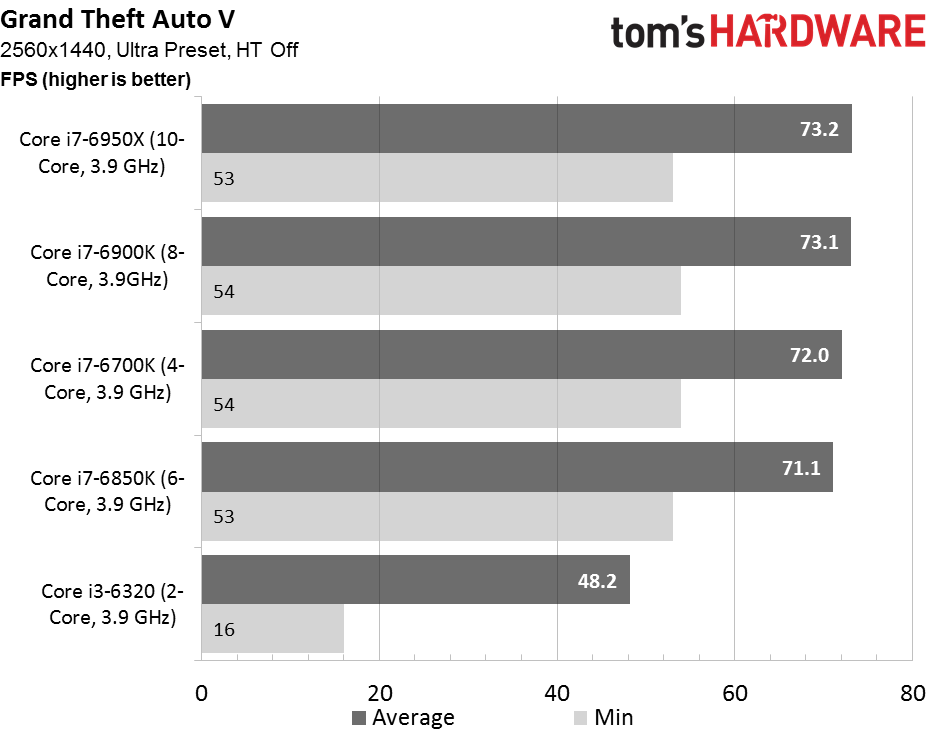



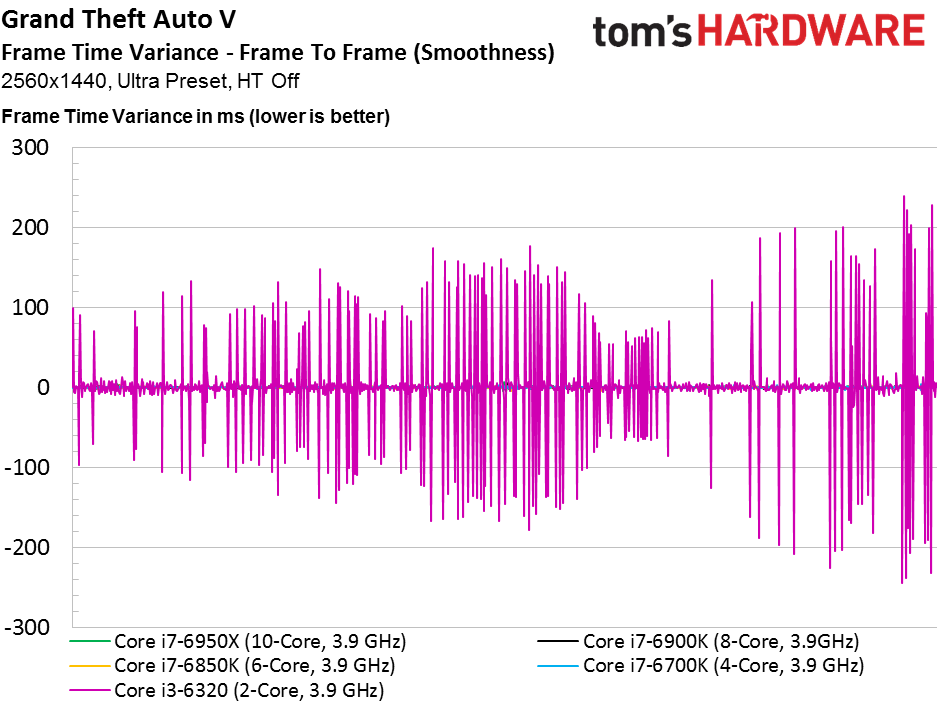
The stuttering remains problematic for the dual-core simulated processor at 2560x1440. However, as more time is spent waiting on the GeForce GTX 1080, our hobbled Core i3’s performance actually improves. Still, the other charts show why you shouldn’t mess with a Pentium (which is basically what we’re looking at here).
The other four CPUs average close to the same frame rate, though our 10- and eight-core configs place first and second, suggesting that GTA is doing enough with those cores to outweigh Skylake’s IPC advantage with four cores. Again, you can see the passage where the -6950X and -6900K establish their minuscule lead.
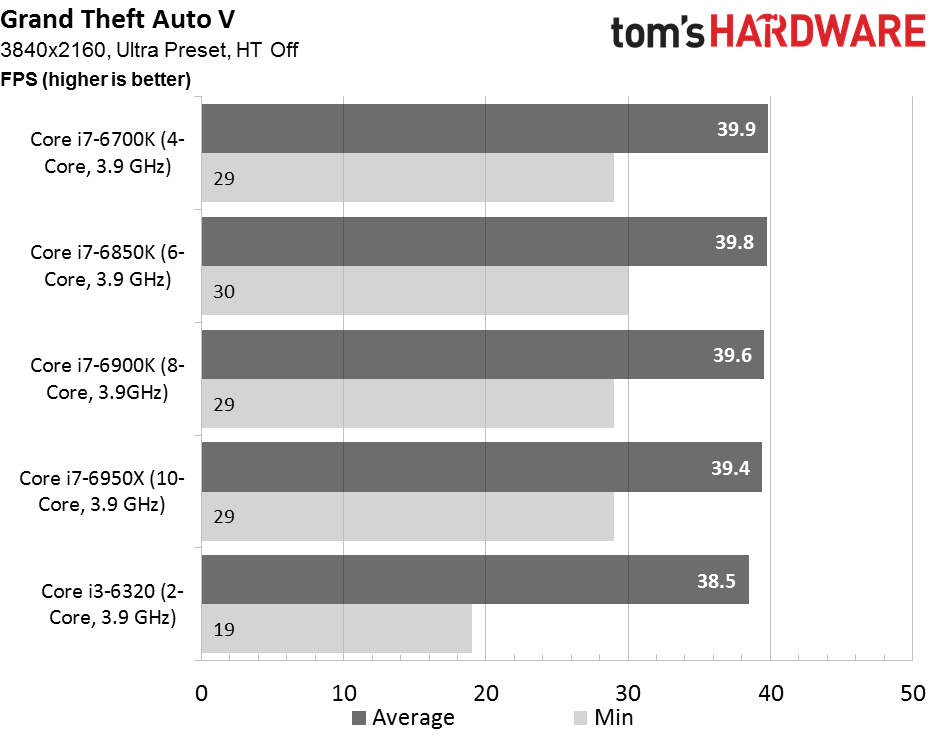




By the time we hit 3840x2160, our GeForce GTX 1080 bottlenecks performance to such an extent that the dual-core CPU with Hyper-Threading disabled no longer stands out in our average frame rate chart.
A notably lower minimum is indicative of issues found in our frame time breakdown, though. Indeed, several sharp spikes during the last third of our benchmark run remind us that even a wholly GPU-bound situation isn’t impervious to interruption from an overwhelmed host processor.
Get Tom's Hardware's best news and in-depth reviews, straight to your inbox.
While the other four CPUs average just under 40 FPS, Intel’s quad-core Skylake CPU at 3.9 GHz shows up at the top of our chart. Its lead isn’t meaningful, but the fact that it’s there tells us throwing more than a Core i7-6700K at 4K with a GTX 1080 under the hood is a misappropriation in GTA.
MORE: Best CPUs
MORE: Intel & AMD Processor Hierarchy
MORE: All CPU Content
Hitman (2016)
Prior to looking at benchmark results, we thought it prudent to do a little digging on each game and its underlying engine, hoping for a deeper understanding of the technology inside. Unfortunately, there’s little information on what IO Interactive’s Glacier 2 engine is optimized to do. We do know that Hitman supports DirectX 12, and that our next installment in this series will look at how CPU utilization/performance changes from the move to DX 11 to 12. But for now, we only have our data to guide us.
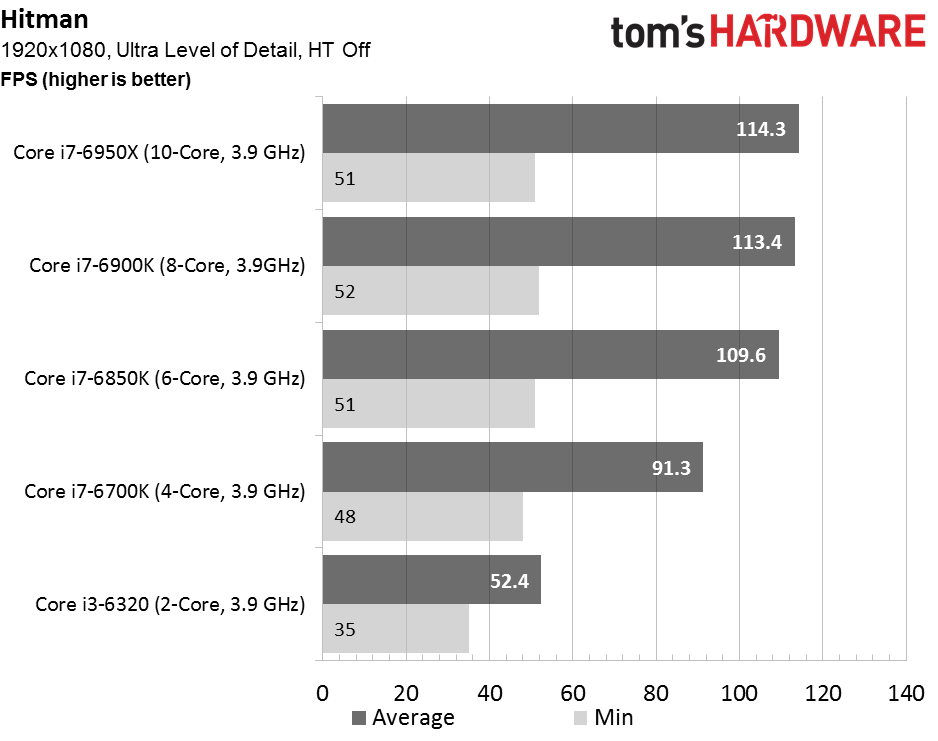




At 1920x1080, there’s a clear jump from the four-core Skylake-based platform to six Broadwell cores at the same 3.9 GHz. There’s a smaller step up to eight cores, but it’s there. Finally, our 10-core config enjoys a slight advantage in its first-place position.
Hitman’s system requirements do specify that you need a quad-core CPU (at least a Core i5-2500K or Phenom II X4 940), and our dual-core i3 with Hyper-Threading disabled suggests why with its 52 FPS average. That figure barely crests the minimum frame rates achieved by the other four processors. Flip through the rest of the charts and you'll see inconsistent frame delivery surface as a much more prevalent issue for two cores.





The same finishing order persists at 2560x1440, though the delta between contenders shrinks as we’d expect. Most interesting, perhaps, is that the three Broadwell-based CPUs continue to enjoy a definite lead over four Skylake cores.
Our dual-core config was distinctly processor-bound at 1920x1080, and it remains so at 2560x1440; very little performance is lost at the higher resolution.



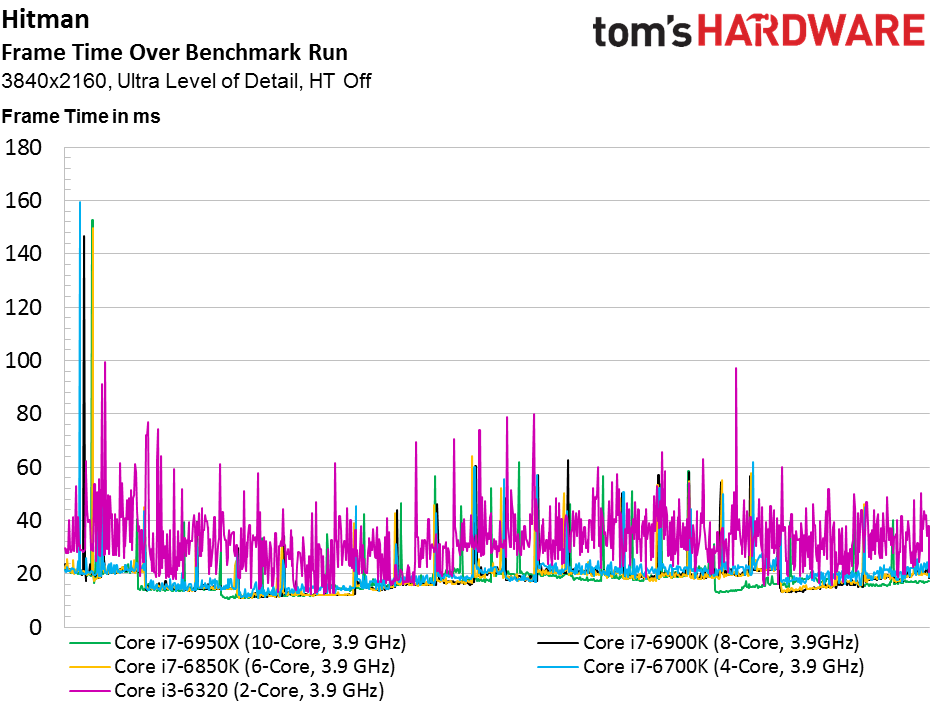

The demands of 4K weigh heavy on our GeForce GTX 1080, pushing the average frame rate of four systems close to 60. They all track closely in our frame rate over time line graph, making it difficult to determine why one might be faster than another.
The two-core setup continues limiting performance. But because Nvidia’s GTX 1080 is doing a lot more work, the consistency issues seen previously aren’t as severe in our frame time and smoothness charts.
Current page: Grand Theft Auto V & Hitman (2016)
Prev Page Ashes of the Singularity & Battlefield 4 Next Page Interview with 4A Games & Metro: Last Light Redux-
ledhead11 Awesome article! Looking forward to the rest.Reply
Any chance you can do a run through with 1080SLI or even Titan SLi. There was another article recently on Titan SLI that mentioned 100% CPU bottleneck on the 6700k with 50% load on the Titans @ 4k/60hz. -
Wouldn't it have been a more representative benchmark if you just used the same CPU and limited how many cores the games can use?Reply
-
Traciatim Looks like even years later the prevailing wisdom of "Buy an overclockable i5 with the best video card you can afford" still holds true for pretty much any gaming scenario. I wonder how long it will be until that changes.Reply -
nopking Your GTA V is currently listing at $3,982.00, which is slightly more than I paid for it when it first came out (about 66x)Reply -
TechyInAZ Reply18759076 said:Looks like even years later the prevailing wisdom of "Buy an overclockable i5 with the best video card you can afford" still holds true for pretty much any gaming scenario. I wonder how long it will be until that changes.
Once DX12 goes mainstream, we'll probably see a balanced of "OCed Core i5 with most expensive GPU" For fps shooters. But for CPU the more CPU demanding games it will probably be "Core i7 with most expensive GPU you can afford" (or Zen CPU). -
avatar_raq Great article, Chris. Looking forward for part 2 and I second ledhead11's wish to see a part 3 and 4 examining SLI configurations.Reply -
problematiq I would like to see an article comparing 1st 2nd and 3rd gen I series to the current generation as far as "Should you upgrade?". still cruising on my 3770k though.Reply -
Brian_R170 Isn't it possible use the i7-6950X for all of 2-, 4-, 6-, 8-, and 10-core tests by just disabling cores in the OS? That eliminates the other differences between the various CPUs and show only the benefit of more cores.Reply -
TechyInAZ Reply18759510 said:Isn't it possible use the i7-6950X for all of 2-, 4-, 6-, 8-, and 10-core tests by just disabling cores in the OS? That eliminates the other differences between the various CPUs and show only the benefit of more cores.
Possibly. But it would be a bit unrealistic because of all the extra cache the CPU would have on hand. No quad core has the amount of L2 and L3 cache that the 6950X has. -
filippi I would like to see both i3 w/ HT off and i3 w/ HT on. That article would be the perfect spot to show that.Reply


